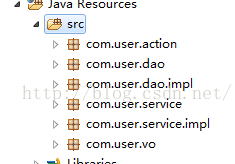SpringMVC简单项目配置
一、首先,SpringMVC框架使用分层开发,分层是为了实现“高内聚,低耦合”。采用“分而治之”的思想,把问题划分开来各个解决,易于控制,延展和分配资源,最重要的是有利于后期项目维护。MVC是指Model(模型)、View(视图)、Controller(控制器),在SpringMVC的编程中一般具有四层,分别是:
表示层:(jsp、html)主要就是界面的展示
控制层:(Contoller、Action)控制界面跳转
业务层:(Service)调用DAO层,实现解耦合目的,虽然不要它也可以运行项目,但是会使项目后期的延展和维护变得困难
持久层:(DAO)也叫数据访问层,实现对数据库的访问
二、然后,注解的使用,在SpringMVC中经常用到注解,使用注解可以极大的节省开发者的时间,下面是几个最重要的注解介绍:
@Repository:标注数据访问层,可以告诉SpringMVC这是一个数据访问层,并将其申明为一个bean,例如UserDao接口的实现类UserDaoImpl,在类上加注解@Repository("userDao"),bean的名称为userDao
@Service:标注业务层,例如UserService接口的实现类,在类上加@Service("userService"),bean的名称为userService
@Controller:控制层,在控制层类上加@Controller即可,确认其是一个控制层类
@Component:当不确定是属于哪层是用这个注解
三、说的再多,不如做一遍,下面是一个简单的跳转并实现登录功能的SpringMVC项目的介绍
1.项目环境搭建,在eclipse下点击左上角File→New→Dynamic Web Projiect,创建项目MySpringMVC,新建项目结构如下
在lib下导入jar包,在这里,需要的jar包有哪些就不介绍了,反正是能多不能少,多了不会报错,不明白就都弄进去吧。在WEB-INF下新建web.xml文件
encodingFilter
org.springframework.web.filter.CharacterEncodingFilter
encoding
UTF-8
forceEncoding
true
encodingFilter
/*
index.jsp
<%@ page language="java" contentType="text/html; charset=UTF-8"
pageEncoding="UTF-8"%>
welcome
This is MySpringMVC!
接下来实现页面的跳转在index.jsp里加入
登录在WEB-INF下新建文件夹webPage,然后建立Login.jsp
<%@ page language="java" contentType="text/html; charset=UTF-8"
pageEncoding="UTF-8"%>
登录界面
/WEB-INF/webPage/
.jsp
spring
org.springframework.web.servlet.DispatcherServlet
contextConfigLocation
/WEB-INF/xmlConfig/webConfig.xml
1
spring
*.do
package com.user.action;
import org.springframework.stereotype.Controller;
import org.springframework.ui.ModelMap;
import org.springframework.web.bind.annotation.RequestMapping;
@Controller
//标明这是一个控制层类
public class UserAction {
@RequestMapping(value = "/toLogin.do")
//响应index.jsp的登录请求
public String login(ModelMap map){
return "/Login";
}
}
点击登录,界面跳转
2.以上是SpringMVC一个简单环境的配置,接下来是数据库的连接,需要在lib下导入mysql的jar包,下面是做一个简单的登录功能,采用mysql数据库,建立如下包结构,有利于分层开发
在WEB-INF下建立文件夹properties,建立db.properties,保存数据库配置信息,配置的信息一定不要错了,这里是我事先建好的一个test数据库,在里面建了个user表,id,name,password三个字段
#myspring Mysql数据库配置
driver=com.mysql.jdbc.Driver
url=jdbc:mysql://localhost:3306/test
user=root
password=123456
org.springframework.web.context.ContextLoaderListener
contextConfigLocation
/WEB-INF/xmlConfig/globalApplication.xml
package com.user.vo;
public class UserVo {
private int id;
private String name;
private String password;
public int getId() {
return id;
}
public void setId(int id) {
this.id = id;
}
public String getName() {
return name;
}
public void setName(String name) {
this.name = name;
}
public String getPassword() {
return password;
}
public void setPassword(String password) {
this.password = password;
}
}
package com.user.dao;
import com.user.vo.UserVo;
public interface UserDao {
public UserVo login(UserVo u);
}
package com.user.dao.impl;
import java.sql.ResultSet;
import java.sql.SQLException;
import java.util.List;
import org.springframework.beans.factory.annotation.Autowired;
import org.springframework.beans.factory.annotation.Qualifier;
import org.springframework.jdbc.core.JdbcTemplate;
import org.springframework.jdbc.core.RowMapper;
import org.springframework.stereotype.Repository;
import com.user.dao.UserDao;
import com.user.vo.UserVo;
@Repository("userDao")
public class UserDaoImpl implements UserDao{
@Autowired
@Qualifier("film-template")//名字跟xml中配置的id要一致
/* 封装一个JdbcTemplate的模板对象 */
private JdbcTemplate jdbcTemplate;
/* 通过set方法注入进来即可 */
public JdbcTemplate getJdbcTemplate() {
return jdbcTemplate;
}
public void setJdbcTemplate(JdbcTemplate jdbcTemplate) {
this.jdbcTemplate = jdbcTemplate;
}
@Override
public UserVo login(UserVo u) {
String sql="select * from user where name=? and password=?";
Object[] param = new Object[]{u.getName(),u.getPassword()};
List la = jdbcTemplate.query(sql,param,new RowMapper() {
public UserVo mapRow(ResultSet rs, int i)
throws SQLException {
UserVo vo = new UserVo();
vo.setId(rs.getInt("id"));
vo.setName(rs.getString("name"));
vo.setPassword(rs.getString("password"));
return vo;
}
});
if(la!=null&&la.size()>0){
return la.get(0);
}else{
return null;
}
}
}
package com.user.service;
import com.user.vo.UserVo;
public interface UserService {
public UserVo login(UserVo u);
}
package com.user.service.impl;
import org.springframework.beans.factory.annotation.Autowired;
import org.springframework.beans.factory.annotation.Qualifier;
import org.springframework.stereotype.Service;
import com.user.dao.UserDao;
import com.user.service.UserService;
import com.user.vo.UserVo;
@Service("userService")
public class UserServiceImpl implements UserService{
@Autowired
@Qualifier("userDao")
private UserDao userDao;
public UserDao getUserDao() {
return userDao;
}
public void setUserDao(UserDao userDao) {
this.userDao = userDao;
}
@Override
public UserVo login(UserVo u) {
// TODO Auto-generated method stub
return userDao.login(u);
}
}
package com.user.action;
import java.io.IOException;
import javax.servlet.http.HttpServletRequest;
import org.springframework.beans.factory.annotation.Autowired;
import org.springframework.beans.factory.annotation.Qualifier;
import org.springframework.stereotype.Controller;
import org.springframework.ui.ModelMap;
import org.springframework.web.bind.annotation.RequestMapping;
import org.springframework.web.bind.annotation.RequestMethod;
import com.user.service.UserService;
import com.user.vo.UserVo;
@Controller
public class UserAction {
@Autowired
@Qualifier("userService")
private UserService userService;
public UserService getUserService() {
return userService;
}
public void setUserService(UserService userService) {
this.userService = userService;
}
UserVo u=new UserVo();
@RequestMapping(value = "/toLogin.do", method = {RequestMethod.GET,RequestMethod.POST })
public String login(ModelMap map,HttpServletRequest request) throws IOException{
return "/Login";
}
@RequestMapping(value="/userLogin", method = {RequestMethod.GET,RequestMethod.POST })
public String loginCheck(ModelMap map,HttpServletRequest request) throws IOException{
String name=request.getParameter("userName");//获取Login.jsp传送过来的参数
String password=request.getParameter("loginPassword");
u.setName(name);
u.setPassword(password);
UserVo vo=userService.login(u);//通过业务层实现对数据访问层的访问
if(vo==null)
return "/error";
else
System.out.println(vo.getId());
map.addAttribute("id",vo.getId());//向前台传送一个名字为id的参数,若能成功得到值,证明成功访问数据库
return "/success";
}
}
<%@ page language="java" contentType="text/html; charset=UTF-8"
pageEncoding="UTF-8"%>
Insert title here
成功,用户的ID为${id}
<%@ page language="java" contentType="text/html; charset=UTF-8"
pageEncoding="UTF-8"%>
Insert title here
失败!
下面是数据库user表中的数据信息
输入用户名admin,密码123456.点击登录
获取参数用户ID是2,数据库连接成功,登录相当于一个查询操作,只要数据库能连通,其他删除,修改,添加操作都挺容易的







